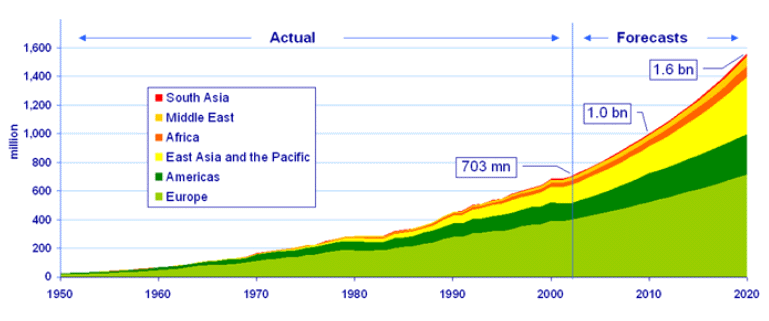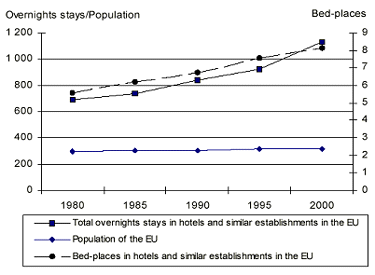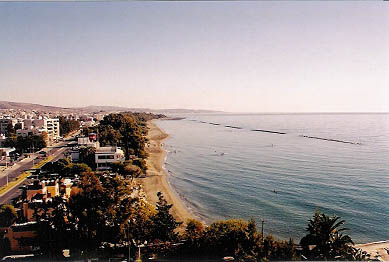|
You are here: /
Introduction / Introducing to Coastal
Tourism
|
Tourism growth has been one of the
major economic and social phenomena of the twentieth
century.
Tourism is the "movement of people, spatially
and temporally, out of their own communities for leisure
and business purposes". A tourist is defined
by the World
Tourism Organisation (WTO) as a "visitor
staying for more than 24 hours in a country visited
for business or leisure purposes".
Therefore, the term Tourism is an umbrella for all
relationships and phenomena associated with people who
are travelling, whatever the reason. It has no clear
boundaries and could be viewed as an industry itself.
Global Tourism
Tourism has expanded dramatically over the last 50
years and has become a global industry. According to
WTO’s forecasts, long-distance travel worldwide will
grow faster (5.4% each year) in the next decades than
travel within regions (3.8%). WTO statistics for 2002
estimated international tourist receipts of US$ 463
billion, a total of 693 million tourist arrivals across
the globe and forecast over one billion arrivals by
2010. European tourism accounts for 2/3 of global tourism
and is expected to double by the year 2025. The Mediterranean
is the World’s number one tourist destination and is
generating 1/3 of global tourist revenues.
The World
Coast Conference (1993) recognised tourism as the
world’s largest single industry and estimated that tourism
constitutes 5-6% of the combined Gross National Product
(GNP) of all nations. In many coastal countries, tourism
is responsible for a much higher percentage of the GNP.
|
Tourism Industry Forecast
WTO’s Tourism 2020 Vision forecasts that international
arrivals are expected to reach over 1.56 billion around
the year 2020. Of these worldwide arrivals, 1.2 billion
will be intraregional and 0.4 will be long-haul travellers.
The total tourist arrivals by region show that around
2020 the top three receiving regions will be Europe
(717 million tourists), East Asia and the Pacific (397
millions) and the Americas (282 million).
|

Source: World Tourism Organization
|
|
|
Exercise for user
What are the top tourist destinations for Europeans?

|
|
Facts and figures
Tourism is one of the strongest economic sectors in
the member states of the European Union (EU). Tourism
activities in all member states involve around 2 million
businesses (mostly small and medium-sized enterprises).
These are currently generating up to 12% of the GDP
(directly or indirectly), 6% of employment (directly)
and 30% of external trade. All of these figures are
expected to increase further as tourism demand is expected
to grow. An analysis of changes in tourism in the EU
over the past 20 years shows that the numbers of bed-places
and overnight stays have increased by almost 64% whilst
the population rose by only 6,2% (EC 2002).

(Source: Statistics in focus Theme 4-40, EC 2002)
In 1999, tourism in EEA countries (members of EU, Norway
and Iceland) has generated US$ 1,040 billion of the
GDP (directly and indirectly). The total share is ranging
from 9.04 % in the Netherlands up to 24.39 % in Iceland.
It is also a strong employment generator with a total
of 18.5 million jobs (direct and indirect employment),
with the share in total employment ranging from 6.92%
in Germany to 20.87% in Iceland (WTTC 2001).
Another indication of the importance of tourism for
national economies is the percentage of current account
balances that is being covered by tourism receipts.
In 1992, the indicator for some Mediterranean countries
was as following: Spain 71%, Greece 28%, Malta 102%
and Cyprus 74%.
However, there are significant regional differences
in European countries with respect to tourism development
and indicating the unequal distribution of economic
benefits. Mallorca is one of the most well-known tourist
resorts where the prosperity of local society is strongly
linked to tourism development, which contributes with
70 % to GDP (EEA 2001).
|
|

Cyprus
Coastal Tourism
Coastal Tourism is based on a unique resource combination
at the border of land and sea environments: sun, water,
beaches, outstanding scenic views, rich biological diversity
(birds, whales, corals etc), sea food and good transportation
infrastructure. Based on these resources, various profitable
services have been developed in many coastal destinations
such as well maintained beaches, diving, boat-trips,
bird watching tours, restaurants or medical facilities.
In the middle of the 20th century coastal tourism
in Europe turned into mass tourism and became affordable
for nearly everyone. Today, 63% of the European holiday
makers prefer the coast (E.C., 1998). The coastal tourism
sector in Europe is getting increasingly competitive,
with tourists expecting more quality for the lowest
possible price. Today’s tourists expect more than sun,
sea and sand, as was the case two decades ago. They
demand a wide variety of associated leisure activities
and experiences including sports, cuisine, culture and
natural attractions. At the same time, local people
in traditional tourist destinations are increasingly
anxious to preserve their own identity, their environment
and their natural, historic and cultural heritage from
negative impacts.
|
Facts
and Figures
Did you know that a coast is the most preferable type
of tourist destination?
Most European holiday makers choose the sea (63%).
Other main types of destinations are the mountains (25%),
cities (25%), and the countryside (23%). At one end,
eight out of ten Greeks chooses the sea - (most probably
the sea in their home country). At the other end, only
three out of ten Finns makes the same choice.
|
Facts and Figures
The Mediterranean region is the world's leading tourist
destination. In less than 20 years, the number of tourists
who visit the Mediterranean is expected to increase from
220 million to 350 million (expected in 2020). 84% of
the tourists comes from Europe, mostly from northern and
western countries. Germany is the largest market followed
by the United Kingdom, France and the Netherlands. Almost
80% of the Mediterranean tourists choose Spain, France,
Italy or Greece (WTO, 2003).
One third of global income by tourism receipts is
received by the Mediterranean. Over the last three years,
2/3 of this income returned to the hands of less than
10 tour operators from northern Europe (WTO, 2003).
Currently, mass tourism is one of the main causes for
ecological losses in the region. Some locations, which
were once pristine, are now beyond repair.
|
|
|
Exercise for user
Tourism is:
- the movement of people, spatially and temporally,
out of their own communities for leisure and
business purposes.
- Any travel of people out of their homes longer
than 24 hours.

|
|
|
Facts and Figures
Mediterranean - one of most endangered ecoregions
globally
WWF has identified 200 regions in the world (called
eco regions), which are crucial for the conservation
of biodiversity. One of these globally important regions
and one of the most endangered is the Mediterranean.
- The 10 key marine areas where there is an urgent
need for new reserves and changes in coastal management
practices:
- Moroccan Mediterranean Coast and Alboran Sea, Coral
Coast of Tunisia (Spain, Morocco, Tunisia)
- Dalmatian Coast and Islands(Croatia)
- Cyrenaica and Gulfs of Sirte and Gabes (Libya, Tunisia)
- Southern Anatolia and Northeast Levantine Coast
and Sea (Turkey)
- Aegean Sea and Coasts (Greece, Turkey)
- Sardinia and Corsica (Italy, France)
- Balearic Islands and Sea (Spain)
- Liguro-Provenzal Sea (France, Italy)
- Southern Tyrrhenian Coast and Sea (Italy)
- South-Western Balkans Coast and Sea, Ionian Islands
(Albania, Greece)
|
|
Exercise for user
With specific reference to coastal use, the space
below lists a set of potential positive environmental
effects and a set of potential negative environmental
effects associated with tourism development.

|
|
|
|
Exercise for user
Do you think that the ageing population has an
effect on tourism?

|
|

|
|